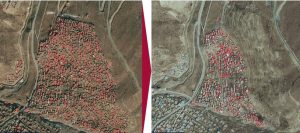
Satellite images of Larung Gar : Before and After
4,700 homes have been demolished at Larung Gar in eastern Tibet, one of the world’s largest institutes of Tibetan Buddhism, leaving 4,800 people homeless. A little over a year since demolition orders were first issued, the Chinese authorities have carried out their planned reduction at the site, according to a new report by Tibet Watch, a British registered charity whose aim is to promote the human rights of the Tibetan people through monitoring, advocacy and research.
In July 2016, the regional Chinese authorities demanded that the population of Larung Gar in eastern Tibet be reduced to a total of 5,000: 3,500 nuns and 1,500 monks. Citing concerns about overcrowding and fire risks, the authorities announced a programme of clearances and demolitions to begin immediately.
Residents of Larung Gar [who were not consulted about the decision], the Central Tibetan Authority, the European Parliament and a number of international non-government organisations believe that the demolitions are an attempt by the Chinese Communist Party to remove any other sources of authority than themselves. Whatever the reason, this is seen as an assault on the religious freedom of the indigenous Tibetan community.
Situated 4,000 metres above sea level, Larung Gar Buddhist Academy is one of the largest and most significant Tibetan Buddhist institutes in the world. It is located in the Larung Valley in Serthar County in Kardze Tibetan Autonomous Prefecture, part of the region that Tibetans know as Kham, eastern Tibet.

File photo
It was established as a monastery, or gar in 1980, by Khenpo Jigme Phuntsok, who is known as the most influential lama of the Nyingma tradition of Tibetan Buddhism in contemporary Tibet, and had grown to become home to anywhere between 10,000 and 40,000 residents. It has welcomed monks, nuns and visiting students from Tibet and China, as well as other countries including South Korea, Singapore and Malaysia, while tens of thousands of people around the globe study Buddhism through online courses taught by Sodargye Rinpoche, a senior Khenpo at Larung Gar.
Before-and-after images from United States satellites in 2016 and 2017 show how houses have been destroyed to make way for wider roads, new pathways and additional space around religious buildings. The photos corroborate reports from residents that the destruction has been aimed at facilitating greater tourism to the area.
Many of the monks and nuns made homeless have been warned against returning to Larung Gar by the Chinese authorities and some have been warned off joining other monasteries.
This is not the first wave of demolitions at Larung Gar; between 1999 and 2013 the institute faced repression on at least five occasions. On two of these the Chinese authorities faced opposition from monks, resulting in large-scale arrests and prison sentences from one to six years.




 Print
Print Email
Email